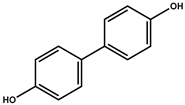Abstract
Bisphenol A (BPA) has become prevalent in the environment due to its extensive use in industrial materials, thus raising significant concerns regarding its potential toxicity and health effects. In this study, an efficient and eco-friendly non-thermal plasma (NTP) was used to catalyze persulfate (PS) for BPA decomposition, and the results showed that the integrated system could effectively degrade BPA. The best performance was attained at a PS to BPA mass ratio of 5:1, with a degradation rate of 91.3% following a 30 min treatment. The degradation rate of BPA increased with increasing input voltage and frequency; conversely, it decreased with an increase in BPA’s initial concentration. Higher BPA degradation rates could be achieved in alkaline environments. Radical quenching experiments revealed that SO4−•, OH•, O2−• and 1O2 were important active substances involved in BPA degradation. Nine intermediate products were identified by liquid chromatography–mass spectrometry (LC-MS), and four degradation pathways were deduced. Additionally, a toxicity analysis of intermediate products was performed. The significant decrease in chemical oxygen demand (COD) during the actual wastewater treatment suggested that the NTP/PS system has good applicability in actual wastewater treatment.
1. Introduction
In recent years, the continuous development of environmental monitoring technologies has facilitated the identification of numerous emerging contaminants, with bisphenol A (BPA) being one of them. BPA is extensively utilized in the production of food packaging, plastic containers, thermal paper and paint coatings [1,2], rendering it prevalent in various environments. Several toxicological studies have revealed that sustained BPA exposure may result in obesity, endocrine disorders and infertility [3,4]; it is also associated with the elevated risk of cardiovascular disease, type II diabetes and various cancers [5]. Many countries, including China, have imposed restrictions on the production and utilization of BPA. Therefore, it is urgent to control and manage BPA pollution in water.
Advanced oxidation processes (AOPs) employ free radicals (e.g., OH•) with strong oxidative properties to destroy recalcitrant organic pollutants and decompose them into low-toxic or non-toxic small molecule substances (CO2 and H2O). Typical AOPs include Fenton catalytic oxidation, wet catalytic oxidation, electrocatalytic oxidation and ozone oxidation [6]. Nonetheless, the majority of them possess certain limitations. Fenton catalytic oxidation utilizes OH• produced by H2O2 and Fe2+ to decompose organic contaminants. This approach presents rapid reactions, a simple operation and minimal environmental impact; yet it is limited by a narrow operational pH range [7,8]. Wet catalytic oxidation has to operate under stringent conditions, including high temperatures and pressures [9]. Ozone possesses a strong oxidizing capability, enabling it to oxidize and decompose organic pollutants. Nonetheless, its high selectivity limits its efficacy in degrading certain organic pollutants [10]. Moreover, the low solubility of ozone in water also contributes to low ozone utilization [11]. Electrocatalytic oxidation presents the advantage of being environmentally friendly in treating organic pollutants, yet it suffers from low efficiency and high energy consumption. In contrast, persulfate (PS) oxidation exhibits high stability and efficiency, a broad pH application range and no secondary pollution [12], rendering it a promising option for environmental pollution remediation. Under various physical and chemical catalytic environments, including thermal, alkaline, UV light, cavitation, electromagnetic radiation and specific catalyst, PS can be directly activated into SO4−• or indirectly produced OH• [6], which efficiently decompose organic pollutants in water.
Non-thermal plasma (NTP) employs an insulating medium to cover the electrode and generates active substances (OH•, O•, O2−•, O3, H2O2, etc.) through high-voltage discharge, thus realizing the efficient destruction of pollutants [13]. It offers advantages including strong oxidation capacity, rapid reaction rates, high degradation efficiency and substantial mineralization [14]. Nonetheless, the energy utilization remains unsatisfactory due to the inefficient utilization of physical effects, including UV radiation, heat and shock waves produced during the discharge process. Choosing an appropriate catalyst or utilizing plasma to catalyze the activation of oxidants can improve energy utilization efficiency [15,16]. Hence, integrating plasma with PS can effectively utilize the physical effects produced during the plasma process to catalyze PS activation. This approach is expected to enhance the energy efficacy of the plasma process and increase the generation of active species, leading to more efficient pollutant removal.
In this study, the synergistic effect of NTP and PS on the degradation of bisphenol A was investigated. The influence of plasma input voltage, pulse frequency, initial BPA concentration, PS dosage and the initial solution’s pH was investigated to determine the appropriate experimental conditions of the system. Electron spin resonance (ESR) analysis and radical scavengers were employed to investigate the existence of active substances in the system and their function in BPA degradation. Furthermore, the alterations in solution pH, UV–visible spectra and three-dimensional fluorescence spectrum throughout the discharge process were assessed to investigate the synergistic degradation mechanism of the NTP/PS system. The intermediate products and pathways of BPA degradation were determined by liquid chromatography–mass spectrometry (LC-MS). Finally, the applicability of the system was evaluated by examining the treatment performance of the NTP/PS system for real wastewater. This study aims to reveal the degradation mechanism of pollutants in the NTP/PS system and provide insights for developing more efficient wastewater treatment technologies.
2. Result and Discussion
2.1. Influence of Various Experimental Parameters
2.1.1. Effects of Discharge Voltage and Pulse Frequency
The energy and velocity of free electrons, as well as the intensity of the ultraviolet radiation, are all affected by the input voltage during the discharge process. As shown in Figure 1a, when the input voltages were 95, 100, 105 and 110 V, the degradation rates of BPA were 44.3%, 68.8%, 74.9% and 84.8%, respectively. The corresponding k values increased from 0.01788 min−1 to 0.06244 min−1 with increasing voltage. The plasma produced a greater number of active substances at a higher input voltage, which increased the probability of collision between pollutants and active substances, thereby improving the degradation rate [17]. In addition, increasing the electric field intensity also enhanced the intensity of ultraviolet light generated from the plasma, which could facilitate the catalytic activation of PS and accelerated the degradation of BPA [18].
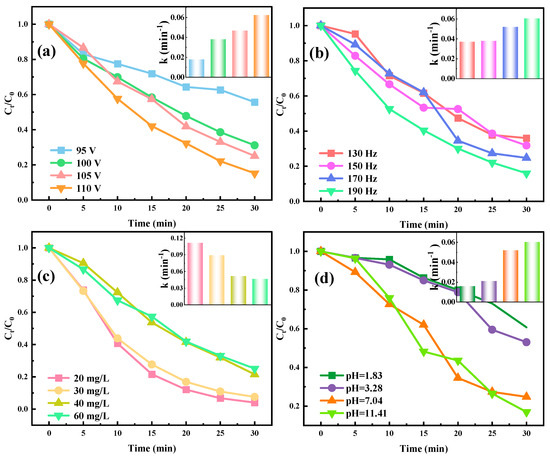
Figure 1.
Effects of input voltage (a); pulse frequency (b); initial concentration (c); and solution pH (d) on BPA degradation.
Figure 1b illustrates the effect of pulse frequency on BPA degradation. When the pulse frequency was 130, 150, 170 and 190 Hz, the BPA degradation rates were 64.0%, 68.1%, 75.2% and 84.0%, respectively, with corresponding k values of 0.03712, 0.03802, 0.05209 and 0.06057 min−1. As the pulse frequency increases, the amounts of high-energy electrons, free radicals, ozone and other active substances produced per unit time increase [19], thereby accelerating the degradation rate of BPA. Notably, an excessively high pulse frequency may decrease the electric energy utilization efficiency; thus, a frequency of 170 Hz was chosen for subsequent experiments.
2.1.2. Effects of Initial BPA Concentration and Solution pH
The initial BPA concentration also significantly influences the BPA degradation in water. As shown in Figure 1c, an increase in the initial BPA concentration led to a gradual decrease in the degradation rate. At an initial concentration of 20 mg/L, the BPA degradation rate and k value were 95.9% and 0.1115 min−1, respectively, whereas the degradation rate and k value decreased by 21% and 58%, respectively, as the initial concentration increased to 60 mg/L. When the energy input was unaltered, the quantity of active substances generated in the system remained unchanged [20]. Consequently, the limited active substances were insufficient to degrade all BPA molecules. Furthermore, some intermediates generated during the BPA degradation may compete with BPA for these active substances [21], thus lowering the degradation efficiency as a whole.
The initial solution’s pH affects the BPA degradation by influencing the type and quantity of free radicals and the reaction mechanism. As shown in Figure 1d, the BPA degradation rate increased from 39.3% to 83.0% and k increased from 0.01598 min−1 to 0.06045 min−1 when the pH increased from 1.83 to 11.41. This indicates that alkaline conditions are more favorable for BPA degradation. PKa1 refers to the dissociation constant when the first dissociation occurs, while pKa2 refers to the dissociation constant when the second dissociation occurs. It was reported that the pKa1 and pKa2 values of BPA are 9.6 and 10.2, respectively [22]. When the solution pH exceeds 9.6, BPA is readily ionized to produce bisphenolate anions, which are more prone to react with active substances [22,23]. More importantly, alkaline environments are more favorable for catalyzing the activation of PS to yield SO4−• and OH• [12,18]. Liang et al. [24] also reported that the predominant radical is SO4−• at solution pH 2–7; both SO4−• and OH• coexist at pH 9, and a further increase in pH will result in OH• being the dominant radical. Therefore, the increased degradation rate observed under alkaline conditions suggests that both SO4−• and OH• may contribute to the degradation of BPA.
2.1.3. Effects of PS Addition
As illustrated in Figure 2, PS addition favored the BPA degradation. In contrast to the 74.9% degradation rate in the individual plasma system, the BPA degradation rate increased to 91.3% at a PS to BPA mass ratio of 5:1. Correspondingly, the kinetic constant attained its maximum value of 0.07909 min−1 when the mass ratio was 5:1. This can be attributed to the ability of plasma to serve as an efficient catalytic activator for PS. The plasma electrons, ozone, ultraviolet radiation and thermal effects during the discharge contributed to the cleavage of peroxide bonds, resulting in the yield of SO4−• and OH• (Equations (1)–(5)) [12,25].

Figure 2.
Effect of PS dosage on BPA degradation: (a) degradation curve, (b) kinetic constant.
Nevertheless, the degradation rate and k value fell as the mass ratio was further increased to 10:1, which could be ascribed to the self-quenching and the recombination reactions of SO4−• (Equations (6) and (7)). The produced SO4−• can be quenched by excess S2O8−, and it can also be recombined into S2O82− [26], which lowered the quantity of highly reactive species in the system and reduced the BPA degradation rate.
2.2. Roles of Active Substances
The generation of OH• and SO4−• in the NTP/PS system was detected by ESR technique, and the results are shown in Figure 3a. The typical four-line spectrum with a peak area ratio of 1:2:2:1 observed in ESR confirmed the generation of OH•, while the equidistant six-line spectrum with a peak area ratio of 1:1:1:1:1:1 suggested the generation of SO4−• [27,28,29,30].
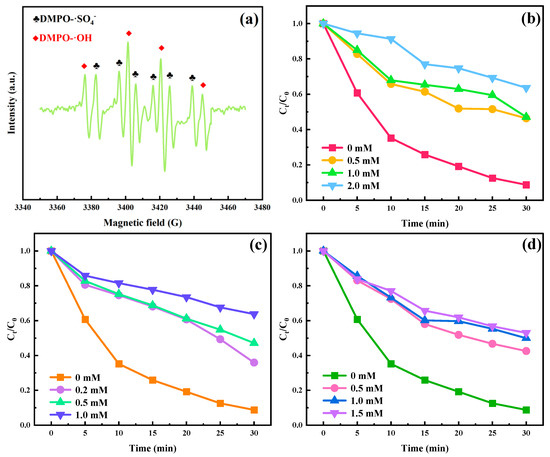
Figure 3.
ESR spectrum in the NTP/PS system (a); effects of Methanol (b), BQ (c) and TEDA (d) on BPA degradation.
Free radical trapping experiments were further conducted to explore the roles of free radicals generated by the NTP/PS system in BPA degradation. Similar to preparing a bisphenol A solution, we added a certain amount of capture agent to the reaction solution, which contained a certain amount of BPA and capture agent. Therefore, during the degradation process, the capture agent could simultaneously consume the corresponding active species to inhibit BPA degradation. Methanol (MeOH) was used to capture OH• and SO4−• [31]. As demonstrated in Figure 3b, the degradation rate of BPA declined with increasing MeOH concentration. Specifically, the degradation rate dropped from 91.3% to 53.7%, 52.9% and 36.4%, respectively, with the addition of 0.5, 1.0 and 2.0 mM of MeOH. This result suggested that OH• and SO4−• were significantly strong oxidative radicals involved in BPA degradation in the NTP/PS system. Given that O2−• serves as an important active substance in the plasma system, benzoquinone (BQ) was introduced to the solution to investigate the role of O2−• in BPA degradation [32]. As shown in Figure 3c, the BPA degradation rates were 91.3%, 64.1%, 52.9% and 36.3% at 0, 0.2, 0.5 and 1.0 mM of BQ addition, respectively. It can be inferred that O2−• plays an important role in the degradation of BPA in the NTP/PS system. On the one hand, O2−• could directly react with BPA to facilitate its degradation. On the other hand, O2−• also played a significant role in catalyzing PS activation [32]. Hence, the quenching of O2−• altered the production of SO4−• within the system, thus leading to a further decrease in the degradation rate of BPA. Additionally, triethylenediamine (TEDA) was employed in the 1O2 quenching experiments [32], and the result demonstrated that the addition of varying TEDA dosages had a substantial impact on the degradation of BPA (Figure 3d). This suggested that 1O2 is also a crucial factor in the degradation of BPA in the NTP/PS system.
2.3. Analysis of BPA Degradation Process
2.3.1. Changes in pH, UV-Vis and Three-Dimensional Fluorescence Spectra
The alteration of the solution’s pH during BPA degradation was monitored. As shown in Figure 4, the NTP/PS system exhibited continuous acidification throughout its operation, which was attributed to the generation of small-molecule organic acids during BPA degradation. During the treatment, BPA and several aromatic intermediate products experienced ring opening, resulting in the production of short-chain aliphatic acids, including formic acid, acetic acid, propanedioic acid and maleic acid [23,33]. This process eventually resulted in a reduction in the solution’s pH.
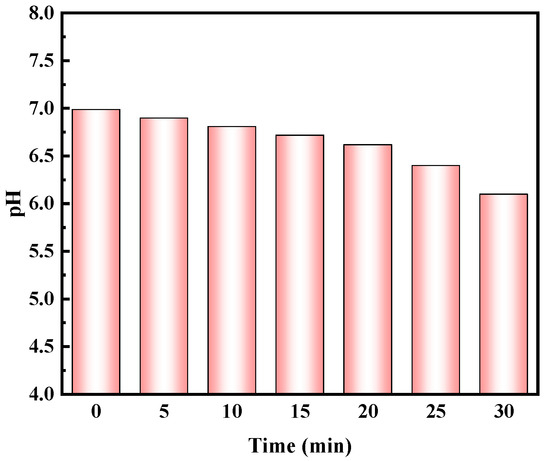
Figure 4.
Degradation process changes in pH.
To further investigate the degradation process of BPA by the NTP/PS system, UV-Vis scans and three-dimensional excitation–emission matrix fluorescence spectroscopy (3DEEM) of BPA solutions under varying treatment times were performed. As displayed in Figure 5, the characteristic absorption peak of BPA appeared at 278 nm, and it diminished with increasing treatment time. After 30 min of treatment, the peak was nearly undetectable, suggesting that BPA was almost completely degraded. Furthermore, the absorbance at wavelengths of 240–263 nm increased with extended treatment time, likely due to the intermediates formed during BPA degradation.
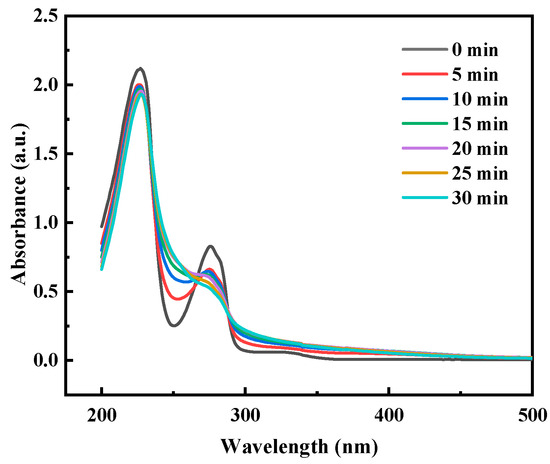
Figure 5.
UV-Vis spectra of the BPA solutions.
In three-dimensional fluorescence spectra, various molecular structures are depicted by the fluorescence emitted from distinct regions [34]. Figure 6 illustrates the 3DEEM spectra of BPA solutions with different discharge times. It was observed that the main fluorescence peak of BPA in the undegraded solution was located in the range of Ex/Em = (270–350 nm)/(340–450 nm). Following a 10 min treatment by the NTP/PS system, the fluorescence of BPA was obviously weakened, signifying that part of BPA has been destroyed. Moreover, the new fluorescence region emerged within the range of Ex/Em = (340–410 nm)/(450–575 nm), suggesting that intermediate products were produced in the degradation process. As can be seen from Figure 6c, the BPA fluorescence peak nearly disappeared, yet the intermediate fluorescence peak intensified after 20 min of treatment. It can be inferred that BPA was basically degraded, and more intermediate products were generated. As the reaction time further extended, the fluorescence intensity of intermediate products was also obviously weakened, signifying the further degradation of BPA.
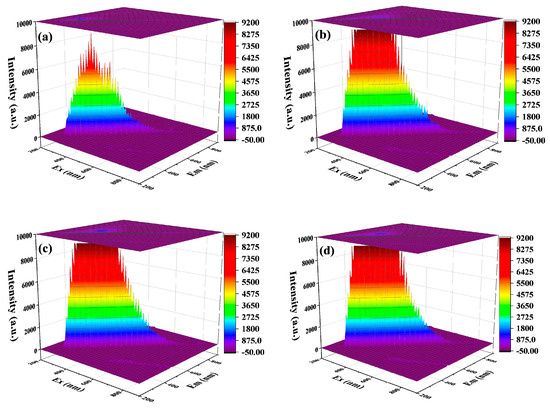
Figure 6.
3DEEFMS of BPA solution after different treatment times: (a) 0 min; (b) 10 min; (c) 20 min; (d) 30 min.
2.3.2. Analysis of Intermediate Products by LC-MS
LC-MS was used to explore the BPA degradation intermediate products in the NTP/PS system, and a total of nine intermediate products were identified, as shown in Table 1.

Table 1.
Intermediate products.
To better predict the degradation pathway of BPA, the Fukui function was used to identify the most active sites on BPA molecules. Figure 7a demonstrates that C3, C20, O30 and O32 were most susceptible to attack by active substances with electrophilic properties, as they possessed the highest f-values. The high f0 values of C5, C25, C2, C21, C1, C23, C4 and C22 in Figure 7b indicated that they were vulnerable to attack by radicals like OH•. Additionally, C1, C23, C5 and C25 exhibited high f+ values, suggesting that they were the most reactive sites for nucleophilic attack. Diagrams of the highest occupied and the lowest unoccupied molecular orbital (HOMO and LUMO) in Figure 7d,e also verified the susceptibility of these sites to electrophilic or nucleophilic reactions. Based on the detected degradation intermediate products and theoretical calculations, four possible degradation pathways of BPA were proposed, as shown in Figure 7f.
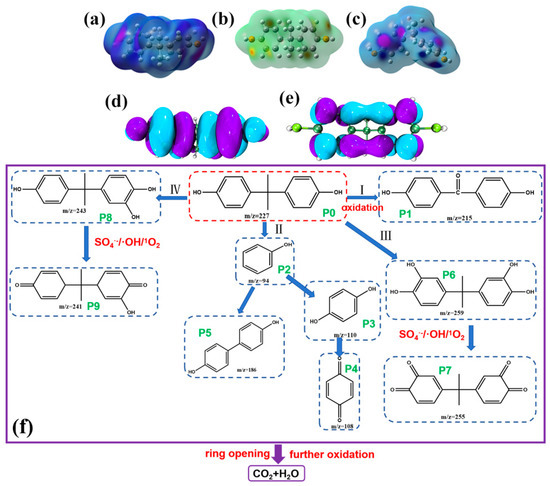
Figure 7.
Diagrams of BPA: (a) f−, (b) f0, (c) f+, (d) HOMO, (e) LUMO, (f) degradation pathways.
In path I, the isopropyl group on BPA was oxidized to a carbonyl group to form P1 [35]. In path II, the C-C bond linking the benzene ring to the isopropyl group was readily cleaved by the attack of 1O2, as C3 and C20 possessed the highest f-values. The generated P2 was further transformed to P3 through hydroxylation, followed by oxidation into P4. Notably, the phenol radical produced by the cleavage of the β-bond was also capable of polymerizing into diphenol (P5) [36]. In paths III and IV, the ortho-C atom of the phenol portion in the BPA molecule was susceptible to attack according to reactive site analysis, which caused hydroxylation to produce P6 and P8. Subsequently, they underwent further oxidation to yield P7 and P9. Ultimately, these intermediate products were further attacked by reactive substances and underwent a ring-opening reaction to mineralize to CO2 and H2O.
2.4. Toxicity Analysis of Intermediate Products
The degradation process of BPA by the NTP/PS system produces a variety of intermediate products, which require evaluation of their toxicity. ECOSAR software (version 2024) was used to analyze the toxicity of intermediate products, focusing on the acute and chronic toxicity to fish, daphnia and green algae. The larger the value, the larger the range of the radar rose chart, indicating a lower toxicity of the substance. The LC50 or EC50 values for BPA were 1.28 mg/L for fish, 5.24 mg/L for daphnid and 1.33 mg/L for green algae; the chronic values (Chvs) were 0.55, 1.77 and 0.227 mg/L for fish, daphnid and green algae, respectively. Hence, BPA can be categorized as “toxic” according to toxicity classification. The toxicities of the degradation intermediate products in different pathways are depicted in Figure 8. The toxicity of P1 in path I was less than that of BPA. In path II, the toxicity of P2, P4 and P5 did not change significantly, whereas P3 demonstrated a substantial reduction in toxicity. In paths III and IV, all four intermediate products exhibited lower toxicity compared to BPA. Overall, the NTP/PS system can effectively reduce the toxicity of pollution.
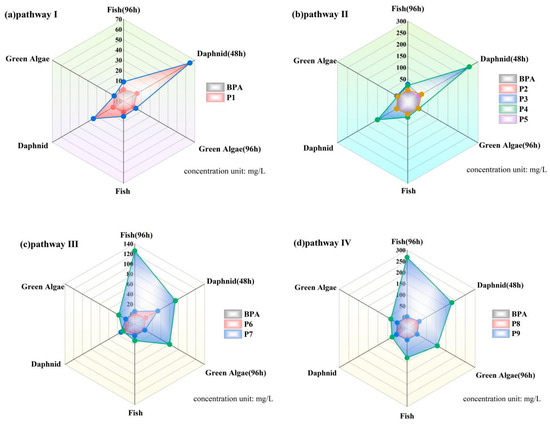
Figure 8.
Toxicity assessment results for BPA: (a) path I; (b) path II; (c) path III; (d) path IV.
2.5. Changes in Actual Wastewater COD and Ammonia Nitrogen
The NTP/PS system was applied to treat actual wastewater to examine its potential applications. The variations in COD and ammonia nitrogen during the treatment are depicted in Figure 9. The COD concentration gradually reduced with increased treatment time, achieving a removal rate of 74.2% after 30 min of treatment. This result indicated that the NTP/PS system significantly improved the biodegradability of the actual wastewater. Despite the ammonia nitrogen concentration increasing as the treatment time extended, it reached only 0.61 mg/L after 30 min of treatment, which was substantially below the effluent discharge standard [37]. These results suggested that the NTP/PS system has good applicability for actual wastewater degradation.

Figure 9.
Water quality objectives: (a) COD, (b) ammonia nitrogen.
3. Materials and Methods
3.1. Chemicals
The main reagents for the experiment are shown in Table 2, and the solutions used in the experiment were prepared with deionized water. The initial concentration of BPA was 20–60 mg/L.

Table 2.
Chemical reagents.
3.2. Experimental Setup
The experimental setup is shown in Figure 10, which includes a plasma reactor, power supply, magnetic stirrer and peristaltic pump. The DBD reactor was designed with a double dielectric water film structure with water ground electrons. The height of the reactor leg and main body are 25 cm and 40 cm, respectively. The width of the reactor is 25 cm. The high-voltage electrode grid is cylindrical, 10 cm in height and 10 cm in circular diameter. The high-voltage electrode is made of a stainless-steel mesh, which is wrapped in quartz glass. The entire quartz glass tube is filled with water, which acts as a ground electrode. The pulse frequency and duty cycle of the pulse power supply (PSPT-2000C) are adjustable, the discharge current is 0.2 A and the voltage is 1.5 kV, supplied by Nanjing Propect Electronic Technology Co., Ltd. (Nanjing, China). The discharge voltage and current were characterized by an oscilloscope (Tektronix, MDO3012) equipped with a voltage probe (Tektronix, P6015A) and a current probe (Tektronix, P6021). The peristaltic pump (longer, BT600-2J) was used for water circulation, and the magnetic stirrer (Sile, B11-1) was used to mix the water evenly. The high-voltage electrode of the plasma reactor is stainless steel mesh, and the ground electrode is a water column filled with internal medium. The treated water flows out from the small uniform holes of the water distributor.
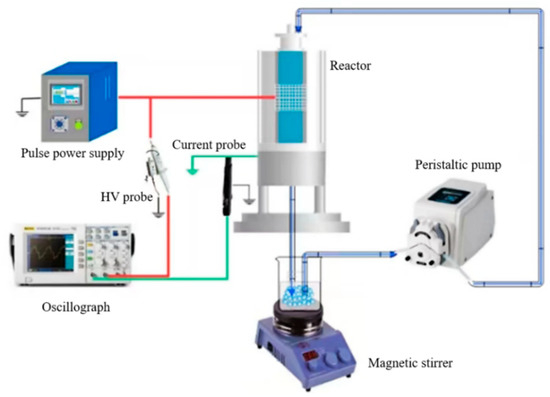
Figure 10.
Experimental setup.
3.3. Analysis Method
Liquid chromatography (LC) was used to determine the concentration of BPA. The chromatographic column was a C18 column (Elite, 4.6 × 250). The volume ratio of acetonitrile to water in the mobile phase was 6:4, and the flow rate was 1 mL/min. The injection volume was 20 μL, the detection wavelength of BPA was 278 nm and the retention time was 8 min. The degradation rate of BPA was calculated according to Equation (8):
where η is the BPA degradation rate (%). C0 is the initial concentration of BPA in mg/L. Ct is the concentration of BPA at t min of treatment in mg/L.
Previous studies have shown that NTP degradation of organic matter in water conforms to the first-order kinetic model [38]. Therefore, the degradation kinetics of BPA were analyzed according to Equation (9):
where C0 and Ct are defined as in Equation (8). k is the reaction rate constant in min−1. t is the reaction time in min.
The concentration of COD and ammonia nitrogen was measured using a multiparameter water quality detector from Shanghai Lianhua Industrial Co., Ltd. (Shanghai, China). The experiment was repeated 3 times, and the results were expressed as mean ± standard error and analyzed by ANOVA using the coefficient of variation [39]. One-way ANOVA was used to ensure that the data p < 0.05, and all data were processed and analyzed by Origin software (Origin2021/Origin64). The mean value was taken for each data point in the experiment, and the percentage of error calculated ranged from 0.7% to 11.8%. The solution pH was determined by a pH meter, UV-Vis was determined by a spectrophotometer and three-dimensional fluorescence profiles were determined by the fluorescence photometer. BPA degradation intermediate products were identified by LC-MS and the toxicity of BPA and its degradation intermediate products was quantitatively assessed using ECOSAR software.
4. Conclusions
This study focuses on the degradation of BPA by the NTP/PS system. The result demonstrated that NTP can effectively catalyze the activation of persulfate, thereby enhancing the degradation rate of BPA. The BPA degradation rate reached a maximum of 91.3% when the mass ratio of PS to BPA was 5:1. Increasing the input voltage, frequency and solution pH was conducive to BPA degradation, while an increase in initial concentration was unfavorable for its degradation. Active substances including SO4−•, OH•, O2−• and 1O2 were involved in the degradation process. The degradation mechanism was explored through the UV-Vis spectrum, three-dimensional fluorescence spectrum, intermediate product identification and theoretical calculations, and four degradation paths were inferred. Toxicity analysis further verified that the NTP/PS system could reduce the BPA toxicity. The NTP/PS system resulted in a reduction in chemical oxygen demand (COD) and a slight increase in ammonia nitrogen when applied to the actual wastewater treatment. This further proved the efficacy of the NTP/PS system in treating organic wastewater.
Author Contributions
Conceptualization, H.G.; Methodology, S.Y. and J.C.; Software, J.C.; Formal analysis, H.Z.; Investigation, S.Y., J.C. and H.G.; Writing – original draft, H.Z. and S.Y.; Writing – review & editing, H.Z.; Project administration, H.G.; Funding acquisition, H.G. All authors have read and agreed to the published version of the manuscript.
Funding
This research was funded by Natural Science Research of Jiangsu Higher Education Institution of China (Grant Number 20KJB610015).
Data Availability Statement
Data are contained within the article.
Conflicts of Interest
The authors declare no conflict of interest.
References
- Wang, J.P.; Zhang, M. Adsorption Characteristics and Mechanism of Bisphenol A by Magnetic Biochar. Int. J. Environ. Res. Public Health 2020, 17, 1075. [Google Scholar] [CrossRef] [PubMed]
- Cheng, F.; Wang, J.L. Biological Strategies for Bisphenol A Degradation: Mechanisms and Pathways. Rev. Environ. Sci. Bio/Technol. 2024, 23, 601–632. [Google Scholar] [CrossRef]
- Liu, B.C.; Qiao, M.; Wang, Y.B.; Wang, L.J.; Gong, Y.; Guo, T.; Zhao, X. Persulfate Enhanced Photocatalytic Degradation of Bisphenol A by G-C3N4 Nanosheets under Visible Light Irradiation. Chemosphere 2017, 189, 115–122. [Google Scholar] [CrossRef] [PubMed]
- Naomi, R.; Yazid, M.D.; Bahari, H.; Keong, Y.Y.; Rajandram, R.; Embong, H.; Teoh, S.H.; Halim, S.; Othman, F. Bisphenol A (BPA) Leading to Obesity and Cardiovascular Complications: A Compilation of Current In Vivo Study. Int. J. Mol. Sci. 2022, 23, 2969. [Google Scholar] [CrossRef]
- Xiao, C.Y.; Wang, L.H.; Zhou, Q.; Huang, X.H. Hazards of Bisphenol A (BPA) Exposure: A Systematic Review of Plant Toxicology Studies. J. Hazard. Mater. 2020, 384, 121488. [Google Scholar] [CrossRef]
- Wang, B.W.; Wang, Y. A Comprehensive Review on Persulfate Activation Treatment of Wastewater. Sci. Total Environ. 2022, 831, 154906. [Google Scholar] [CrossRef]
- Xavier, S.; Gandhimathi, R.; Nidheesh, P.V.; Ramesh, S.T. Comparison of Homogeneous and Heterogeneous Fenton Processes for the Removal of Reactive Dye Magenta MB from Aqueous Solution. Desalin. Water Treat. 2015, 53, 109–118. [Google Scholar] [CrossRef]
- Lee, D.-K.; Cho, I.-C.; Lee, G.-S.; Kim, S.-C.; Kim, D.-S.; Yang, Y.-K. Catalytic Wet Oxidation of Reactive Dyes with H2/O2 Mixture on Pd–Pt/Al2O3 Catalysts. Sep. Purif. Technol. 2004, 34, 43–50. [Google Scholar] [CrossRef]
- Xue, Y.; Wang, W.; Zhang, Y.; Fan, Q.; Zhang, Y.; Ling, C.; Pan, Y. Boron/Fe2+/H2O2 combined with resins process cost-effectively remove Ni(II) in wastewater containing Ni-EDTA: Performance and mechanism. J. Environ. Chem. Eng. 2024, 12, 114112. [Google Scholar] [CrossRef]
- Yuan, Y.C.; Liu, J.; Gao, B.; Hao, J.L. Ozone Direct Oxidation Pretreatment and Catalytic Oxidation Post-Treatment Coupled with ABMBR for Landfill Leachate Treatment. Sci. Total Environ. 2021, 794, 148557. [Google Scholar] [CrossRef]
- Wang, J.; Chen, H. Catalytic Ozonation for Water and Wastewater Treatment: Recent Advances and Perspective. Sci. Total Environ. 2020, 704, 135249. [Google Scholar] [CrossRef] [PubMed]
- Liu, Z.B.; Ren, X.; Duan, X.; Sarmah, A.K.; Zhao, X.S. Remediation of Environmentally Persistent Organic Pollutants (POPs) by Persulfates Oxidation System (PS): A Review. Sci. Total Environ. 2023, 863, 160818. [Google Scholar] [CrossRef] [PubMed]
- Puyang, C.D.; Han, J.G.; Guo, H. Degradation of Emerging Contaminants in Water by a Novel Non-Thermal Plasma/Periodate Advanced Oxidation Process: Performance and Mechanisms. Chem. Eng. J. 2024, 483, 149194. [Google Scholar] [CrossRef]
- Liu, Y.N.; Duan, J.P.; Zhou, Q.; Zhu, L.X.; Liu, N.; Sun, Z.Y. Effective Degradation of Lindane and Its Isomers by Dielectric Barrier Discharge (DBD) Plasma: Synergistic Effects of Various Reactive Species. Chemosphere 2023, 338, 139607. [Google Scholar] [CrossRef]
- Belkessa, N.; Assadi, A.A.; Bouzaza, A.; Nguyen-Tri, P.; Amrane, A.; Khezami, L. A Review of Non-Thermal Plasma -Catalysis: The Mutual Influence and Sources of Synergetic Effect for Boosting Volatile Organic Compounds Removal. Environ. Res. 2024, 257, 119333. [Google Scholar] [CrossRef]
- Li, Y.; Zhang, H.; He, J.; Luo, Y.; Miruka, A.C.; Zhang, A.; Liu, Y. Synergistic Performance and Mechanisms of Plasma and Peracetic Acid for Antibiotic Degradation in Water. Chem. Eng. J. 2024, 498, 155096. [Google Scholar] [CrossRef]
- Chen, Y.; Sun, L.; Yu, Z.B.; Wang, L.; Xiang, G.L.; Wan, S.G. Synergistic Degradation Performance and Mechanism of 17β-Estradiol by Dielectric Barrier Discharge Non-Thermal Plasma Combined with Pt–TiO2. Sep. Purif. Technol. 2015, 152, 46–54. [Google Scholar] [CrossRef]
- Liu, S.; Kang, Y. Underwater Bubbling Plasma Assisted with Persulfate Activation for the Synergistic Degradation of Tetracycline Hydrochloride. Environ. Res. 2024, 240, 117539. [Google Scholar] [CrossRef]
- You, C.-S.; Jung, S.-C. Decomposition of the Antibiotic Sulfamethoxazole by the Liquid-Phase Plasma Process Enhanced by Peroxymonosulfate. J. Ind. Eng. Chem. 2024, 131, 422–431. [Google Scholar] [CrossRef]
- Cheng, J.S.; Fan, Y.Y.; Pei, X.Y.; Tian, D.; Liu, Z.W.; Yang, L.Z.; Feng, E.; Ji, H.F.; Chen, Q. An Energy Efficient Process for Degrading Perfluorooctanoic Acid (PFOA) Using Strip Fountain Dielectric Barrier Discharge Plasma. Water 2022, 14, 2420. [Google Scholar] [CrossRef]
- Wang, B.W.; Zhang, Y.J.; Wang, Y. Synergistic Degradation Levofloxacin through Dielectric Barrier Discharge and Sodium Persulfate. J. Environ. Chem. Eng. 2023, 11, 111158. [Google Scholar] [CrossRef]
- Yu, W.L.; Wang, Y.; Wan, S.G.; Sun, L.; Yu, Z. Ultrahigh-Efficient BiOBr-x%La@y%CNQDs Nanocomposites with Enhanced Generation and Separation of Photogenerated Carriers towards Bisphenol A Degradation and Toxicity Reduction. Chemosphere 2022, 308, 136390. [Google Scholar] [CrossRef]
- Yang, J.; Zeng, D.Q.; Hassan, M.; Ma, Z.B.; Dong, L.Q.; Xie, Y.; He, Y.L. Efficient Degradation of Bisphenol A by Dielectric Barrier Discharge Non-Thermal Plasma: Performance, Degradation Pathways and Mechanistic Consideration. Chemosphere 2022, 286, 131627. [Google Scholar] [CrossRef]
- Liang, C.J.; Su, H.-W. Identification of Sulfate and Hydroxyl Radicals in Thermally Activated Persulfate. Ind. Eng. Chem. Res. 2009, 48, 5558–5562. [Google Scholar] [CrossRef]
- Shang, K.F.; Li, W.F.; Wang, X.J.; Lu, N.; Jiang, N.; Li, J.; Wu, Y. Degradation of P-Nitrophenol by DBD Plasma/Fe2+/Persulfate Oxidation Process. Sep. Purif. Technol. 2019, 218, 106–112. [Google Scholar] [CrossRef]
- Wang, B.W.; Li, X.Y.; Wang, Y. Degradation of Metronidazole in Water Using Dielectric Barrier Discharge Synergistic with Sodium Persulfate. Sep. Purif. Technol. 2022, 303, 122173. [Google Scholar] [CrossRef]
- Wu, Y.; Song, C.; Yu, X.; Shen, X.; Xu, L.; Zhang, Y.; Gong, H.; Xia, C.; Gan, L. Waste polypropylene filter induced synthesis of pure phase Fe3O4 and ZVI incorporated carbon composite for non-radical peroxymonosulfate activation dominated sulfameth-oxazole degradation: Singlet oxygen versus electron transfer process. Chem. Eng. J. 2024, 480, 147984. [Google Scholar] [CrossRef]
- Yu, X.; Wang, L.; Shen, X.; Wu, Y.; Xu, L.; Zhang, Y.; Shi, J.; Gan, L. New insight into the S and N co-doped poplar biochar for efficient BPA removal via peroxymonosulfate activation: S for adsorptive removal and N for catalytic removal. Sep. Purif. Technol. 2024, 354, 128809. [Google Scholar] [CrossRef]
- Xu, W.; Wang, L.; Shen, X.; Wu, Y.; Xu, L.; Zhang, Y.; Shi, J.; Gan, L. Lignin regulating the active sites and peroxymonosulfate activation capacities of iron incorporated 1D carbon nanofiber for efficient organic pollutant degradation. Sep. Purif. Technol. 2025, 354, 129156. [Google Scholar] [CrossRef]
- Huo, Y.; Yuan, S.; Zhang, N.; Pei, C.; Pan, Y.; Zhang, Y.; Mei, X.; Qiao, W.; Xu, L.; Gan, L. Important role of cellulose and lignin in controlling the crystal structure of iron-carbon composite: Fe3C surpassing Fe0 in activating peroxymonosulfate. Sep. Purif. Technol. 2025, 355, 129752. [Google Scholar] [CrossRef]
- Wang, Q.C.; Zhang, A.; Li, P.; Héroux, P.; Zhang, H.; Yu, X.; Liu, Y.N. Degradation of Aqueous Atrazine Using Persulfate Activated by Electrochemical Plasma Coupling with Microbubbles: Removal Mechanisms and Potential Applications. J. Hazard. Mater. 2021, 403, 124087. [Google Scholar] [CrossRef] [PubMed]
- Li, Z.; Jiang, W.X.; Huang, J.W.; Wang, Y.W.; Guo, H. ZnO Promoted Persulfate Activation in Discharge Plasma System for Ofloxacin Degradation. Catalysts 2023, 13, 847. [Google Scholar] [CrossRef]
- Guo, H.; Wang, H.J.; Wu, Q.; Li, J. Degradation and Mechanism Analysis of Bisphenol A in Aqueous Solutions by Pulsed Discharge Plasma Combined with Activated Carbon. Sep. Purif. Technol. 2018, 190, 288–296. [Google Scholar] [CrossRef]
- Song, S.; Huang, Y.; Du, Y.; Xiao, S.; Han, S.; Hu, K.; Zhang, H.; Wang, H.; Wu, C.; Qiong, A. Oxidation of Ciprofloxacin by the Synergistic Effect of DBD Plasma and Persulfate: Reactive Species and Influencing Factors Analysis. Plasma Sci. Technol. 2023, 25, 025505. [Google Scholar] [CrossRef]
- Pei, X.Y.; Ren, H.Y.; Liu, G.S.; Cao, G.L.; Xie, G.J.; Xing, D.F.; Ren, N.Q.; Liu, B.F. Non-Radical Mechanism and Toxicity Analysis of β-Cyclodextrin Functionalized Biochar Catalyzing the Degradation of Bisphenol A and Its Analogs by Peroxydisulfate. J. Hazard. Mater. 2022, 424, 127254. [Google Scholar] [CrossRef]
- Roy, D.; Neogi, S.; De, S. Mechanistic Investigation of Photocatalytic Degradation of Bisphenol-A Using MIL-88A(Fe)/MoS2 Z-Scheme Heterojunction Composite Assisted Peroxymonosulfate Activation. Chem. Eng. J. 2022, 428, 131028. [Google Scholar] [CrossRef]
- GB 18918-2002; Discharge Standard of Pollutants for Municipal Wastewater Treatment Plant. State Environmental Protection Administration: Beijing, China, 2002.
- Su, Y.; Yang, Y.; Jiang, W.; Han, J.; Guo, H. A novel strategy of peracetic acid activation by dielectric barrier discharge plasma for bisphenol a degradation: Feasibility, mechanism and active species dominant to degradation pathway. Chem. Eng. J. 2023, 476, 146469. [Google Scholar] [CrossRef]
- Zhan, J.; Zhang, A.; Héroux, P.; Guo, Y.; Sun, Z.; Li, Z.; Zhao, J.; Liu, Y. Remediation of perfluorooctanoic acid (PFOA) polluted soil using pulsed corona discharge plasma. J. Hazard. Mater. 2019, 387, 121688. [Google Scholar] [CrossRef]
Disclaimer/Publisher’s Note: The statements, opinions and data contained in all publications are solely those of the individual author(s) and contributor(s) and not of MDPI and/or the editor(s). MDPI and/or the editor(s) disclaim responsibility for any injury to people or property resulting from any ideas, methods, instructions or products referred to in the content. |
© 2024 by the authors. Licensee MDPI, Basel, Switzerland. This article is an open access article distributed under the terms and conditions of the Creative Commons Attribution (CC BY) license (https://creativecommons.org/licenses/by/4.0/).





